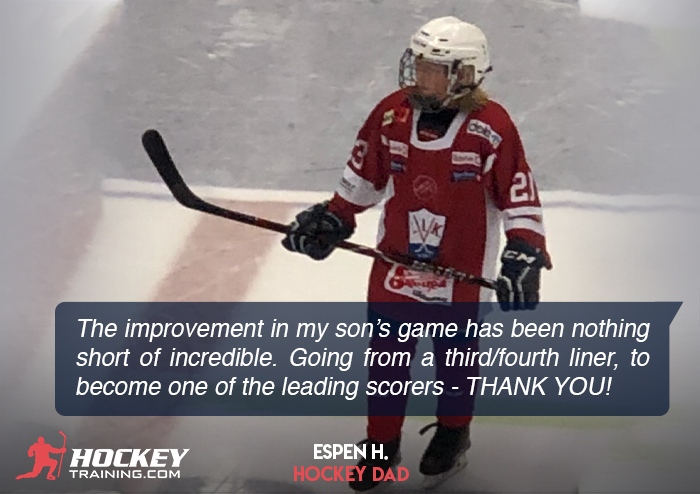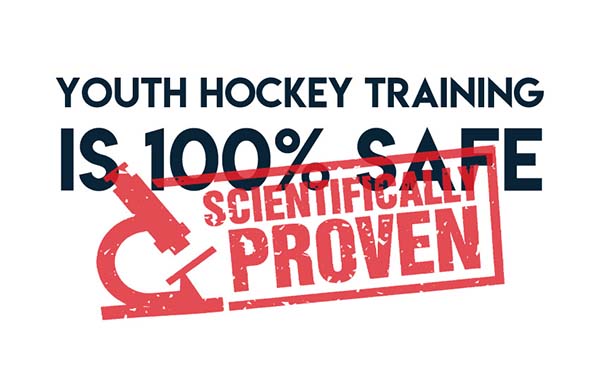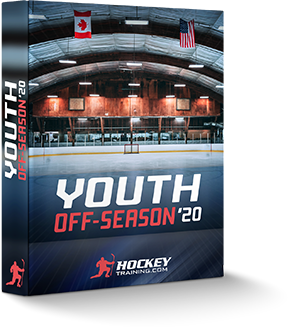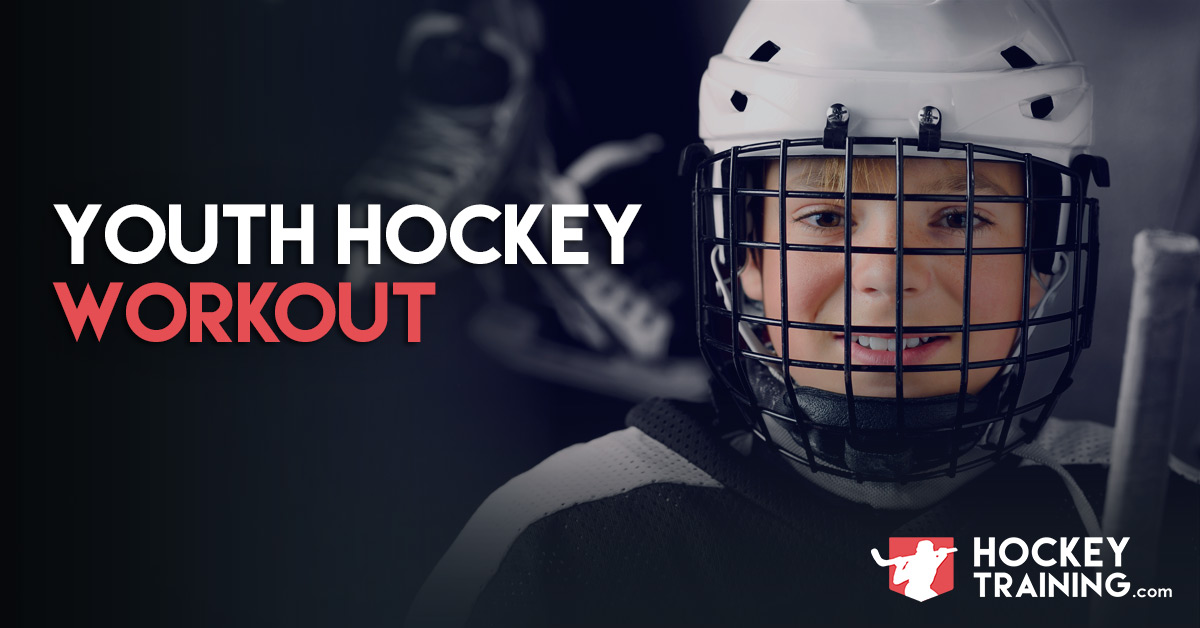**Before checking out this article, I highly recommend downloading our FREE MVP Youth Hockey Training Package here that contains more information and workouts for you to take your kids performance to the next level**
Hockey training for kids has quickly become one of the most popular topics here at HockeyTraining.com.
Parents, coaches, and hundreds of youth players have been all over the articles, videos, workouts, and full hockey workout programs we have developed here and we have heard back nothing but great results.

Youth training is incredibly effective at promoting hockey performance, as well as the necessary strength and conditioning youth athletes can benefit from out there on the ice.
It’s important to understand that youth athletes are not mini-adults.
Adolescent and adult training volume and intensity recommendations likely exceed in almost all scenarios what’s ideal for the recoverability, safety, and “mental readiness” of youth athletes.
As a parent or coach, if you have no idea what you’re doing, it’s always best to underestimate the fitness level of the athlete and work your way up from there.
Slowly work your way up to a point where the athlete finds their limit gradually over time. This is dramatically superior to coming out of the gates too strong and training the athlete too hard or presenting them with a workout or technique they can’t do.
Not only is this counterproductive for physiology, but it’s also counterproductive for psychology.
Tying extreme difficulty, techniques they can’t properly execute that lead to frustration, and an overall “no fun” attitude to training early on can damage their love of the game and their long-term psychology towards the off-ice strength and conditioning world.
Not good!
Keep it simple, keep it fun, and keep it safe.
The best part is, you can check all of the above boxes while still creating an optimal, results-producing workout program.
Youth Hockey Training Myths
Moving on, it’s important to understand the fallacies that spread like wildfire about the myths behind Youth Training are simply untrue; stunted growth and extreme danger being just a couple of the many myths.
For a quick rundown on this, I recommend you check out our Youth Training Myth video:
Youth hockey workout programs should ideally be created in a manner that revolves around fatigue management.
Number one, because you can only make progress based on what you can effectively recover from.
Number two, because increasing levels of fatigue will lead to increasing levels of fits being thrown the moment you announce it’s time to get ready for practice or for another workout.
Nobody needs that.
All jokes aside, fatigue management is absolutely critical in the long-term development of youth athletes.

One of the most important things you could ever do with an athlete in the youth stage is, not provide them information, but instill positive habits in them that they will take into their adolescent and adult lives.
Successful athletes are not successful due to single great moments of motivation, they are successful because of the positive habits they have developed over the years that have gradually lead to big picture success.
1% may not seem like a lot, but guess what that number turns into after 1% is executed 100 days in a row?
Habits form success and habits are very strongly formed in the youth years.
In order to develop habits, you need to incorporate one small easy thing for them to do at a time.
You can start with one workout a week, you can start with one exercise per week, you can start with just increasing their water intake; whatever this may be, doing one thing at a time is likely going to be the most successful route for you to take here.
As a basic guideline, one new thing every two weeks is a good place to start for most all youth athletes.
This prevents them from being overwhelmed but also allows enough time (14-days) in order for it to actually become a habit instead of just a new event.
Youth Hockey Training Example Schedule
Once you get rolling with developing habits, the initial Youth hockey workout schedule should look a little something like:
Day 1: Total Body Workout 1
Day 2: Off
Day 3: Total Body Workout 2
Day 4: Off
Day 5: Total Body Workout 3
Day 6: Conditioning
Day 7: Off
There are many variations that can be made here, but that is the ideal starting point for scheduling.
Within that scheduling, you have the structure of your programming, this programming should be sequenced in a way that prioritizes hockey performance, but also respects the needs and limitations of the youth athletes.
Here’s the structure you should be following as a parent or coach moving forward into your youth programming:
Phase 1 of the workout: A proper warm-up
Phase 2 of the workout: Foundational exercises to improve fitness level and are correlated to hockey performance
Phase 3 of the workout: Cool down and stretching routine
Example Youth Hockey Workout
Here’s an example of what all three phases should look like in a youth hockey workout.
Warm-Up
Hockey Workout For Kids
A: Split squat jumps – 5 x 4-8/leg [60 secs rest]
B: Push-ups with feet elevated – 3 x 8-15 [60 secs rest]
C: Alternating prisoner reverse lunges – 3 x 8-15/leg [60 secs rest]
D: Bodyweight inverted row with a pronated grip – 3 x 8-15 [60 secs rest]
E: Side to side walking plank – 3 x 12-15/side [60 secs rest]
To see this workout performed in real-time, check out Kevin’s video on YouTube above.
When it comes to training with kids under 15, we recommend bodyweight-only work, while always keeping a close eye on proper technique.
Cool Down and Stretching Routine
A: Grounded frog stretch
B: Grounded glute stretch
C: Seated piriformis stretch
D: Hip flexor stretch
E: Calf/Achilles stretch
*Instead of counting, perform each stretch for 10-15 deep diaphragmatic breaths.
To watch this excellent hockey specific speed development stretching strategy in real time, check out our video on YouTube here:
The Solution To Help Your Kid Become A New And Improved Hockey Player
Youth athletes can and should be doing off-ice work throughout the year in order to develop their bodies, minds, and performance to become the best hockey players they can be.
It’s safe, effective, healthy; and when you incorporate the once-at-a-time habit-building strategy, it can be a very fun and great way for you to bond with your kid or athlete.
If you want a complete “done for you” solution, the all-new Youth Off-Season 2020 Hockey Training System was designed to take all of the guesswork out of it for you so you can rest assured that your kid is doing everything in both the safest and most effective way.

This complete bodyweight-only training system includes six phases of an elite off-season youth hockey training program that you can perform at home and anytime you want.
Beyond this, it also includes 20+ different fun game templates that you can use that are specific to hockey strength, speed, agility, and conditioning development.
Real progress comes from real hockey specific training, and this type of programming only comes from a hockey performance specialist.
You can’t find hockey-specific results in a non-hockey-specific program, and this is something rarely talked about in the hockey world.
Most youth hockey players just “stay active” in the off-season. Although this isn’t a bad thing at all, after going through this article, you can start to see how general “staying active” really is.
Instead, I recommend coaches and parents incorporate activities that are still very fun and engaging for kids but have a stronger foundation of sports science behind them to translate into real hockey performance.
The days of guessing and hoping your kid will become a better hockey player are over – get instant access to the Youth Off-Season 2020 Program here so your kid can leave fans, coaches, and scouts jaws on the floor with how much progress they have made in a single off-season.


I’ve been really enjoying reading your blog posts on hockey training and this one on youth training is directly related to my current situation. My son is 9 and has embarked on his first year of travel hockey. The increased commitment has been a bit of a shock to him, so i’m trying to help him with some time management strategies, for example, stick handle while doing math facts. Practice spelling words on the drive to practice. and now for the one that I would like advice on.
Our walk to the bus stop is about 50 yards, uphill about 30-35% grade. I want to suggest that we do walking lunges instead of just walking. I know that the lunge puts more emphasis on the vastus medialis and i’m concerned about creating an imbalance in his legs that could lead to injury or some type of discomfort. I think that skaters tend to have underdeveloped “tear drops” any way, and the hip stretching and ham/glute recruitment of the lunge should make it a perfect compliment, but i am no pro. Do you think this would be a good idea?
Hey Mike!
Walking lunges can be a great idea for youth athletic development for all of the reasons you mentioned, and the fact that it’s not with a load but still increased in difficulty due to the uphill grade is a great way to keep it challenging. If your son is committed and having fun, this is good stuff.
Beyond that, at that age and exercise volume you won’t have to worry about a structural balance issue.
Hey dan what can I do to get faster
Hey Owen!
This is a bit of a loaded question since there are a lot of factors here, but I created a free full manual you can check out over here to get started! Go here: https://www.hockeytraining.com/speed/